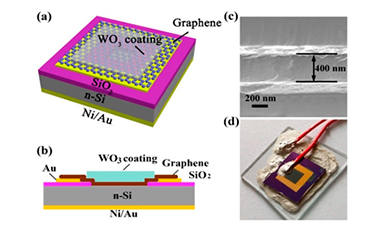Products & Technology
Hydrogen gas sensor
Hydrogen gas is attracting attention as an eco-friendly next-generation energy source, but it is a dangerous combustible material that can cause an explosion even with small flames. A sensor capable of detecting such hydrogen gas is referred to as a hydrogen gas sensor. It can be applied to various hydrogen fields such as the prevention of accidents caused by hydrogen gas leakage and the hydrogen fuel cell market.
-
Device architecture of the tandem gasochromic-Pd-WO3/graphene/Si optoelectronic hydrogen sensor.
-
Sensing mechanism of the Pt@rGO nanocomposite sensor toward hydrogen
-
Gas sensing mechanism of Au/rGO/ZnO sensor in (a) air (b) air with UV light, and (c) H2 environment with UV irradiation.
Advantages and Comparisons of Graphene Hydrogen Gas Sensors
A graphene-based hydrogen gas sensor capable of precise measurement at room temperature.
It is useful for hydrogen gas detection with explosive properties and has excellent electronic mobility of high-performance sensors at ppm or ppm levels, enabling precise gas measurement even with a small amount of gas concentration.
| Item | CNT & Other Sensors | GrapheneLab Sensors |
|---|---|---|
| Operating Temperature | CNT & Other Sensors 300°C~500°C |
GrapheneLab Sensor RT (Room Temperature) |
| Power Consumption / Heater · Presence | CNT & Other Sensors Very Big (heater : O) |
GrapheneLab Sensor Very Small (heater : X) |
| Responsiveness |
CNT & Other Sensors Very Small(Small current & responsiveness and difficult to measure due to a small number of free electrons) |
GrapheneLab Sensor Very Big (easy to measure) |
| Recovery | CNT & Other Sensors Very Slow (several Min.~dozens of Min.) |
GrapheneLab Sensor Very Fast (within several Sec.) |
| Reaction Speed | CNT & Other Sensors Very Slow (several Sec.~Several of Min.) |
GrapheneLab Sensor Several Sec. |
| Measurement Unit | CNT & Other Sensors ppm (a millionth) |
GrapheneLab Sensor ppb (a billionth) |
| Environment Temperature | CNT & Other Sensors -20°C~80°C |
GrapheneLab Sensor -20°C~80°C |






